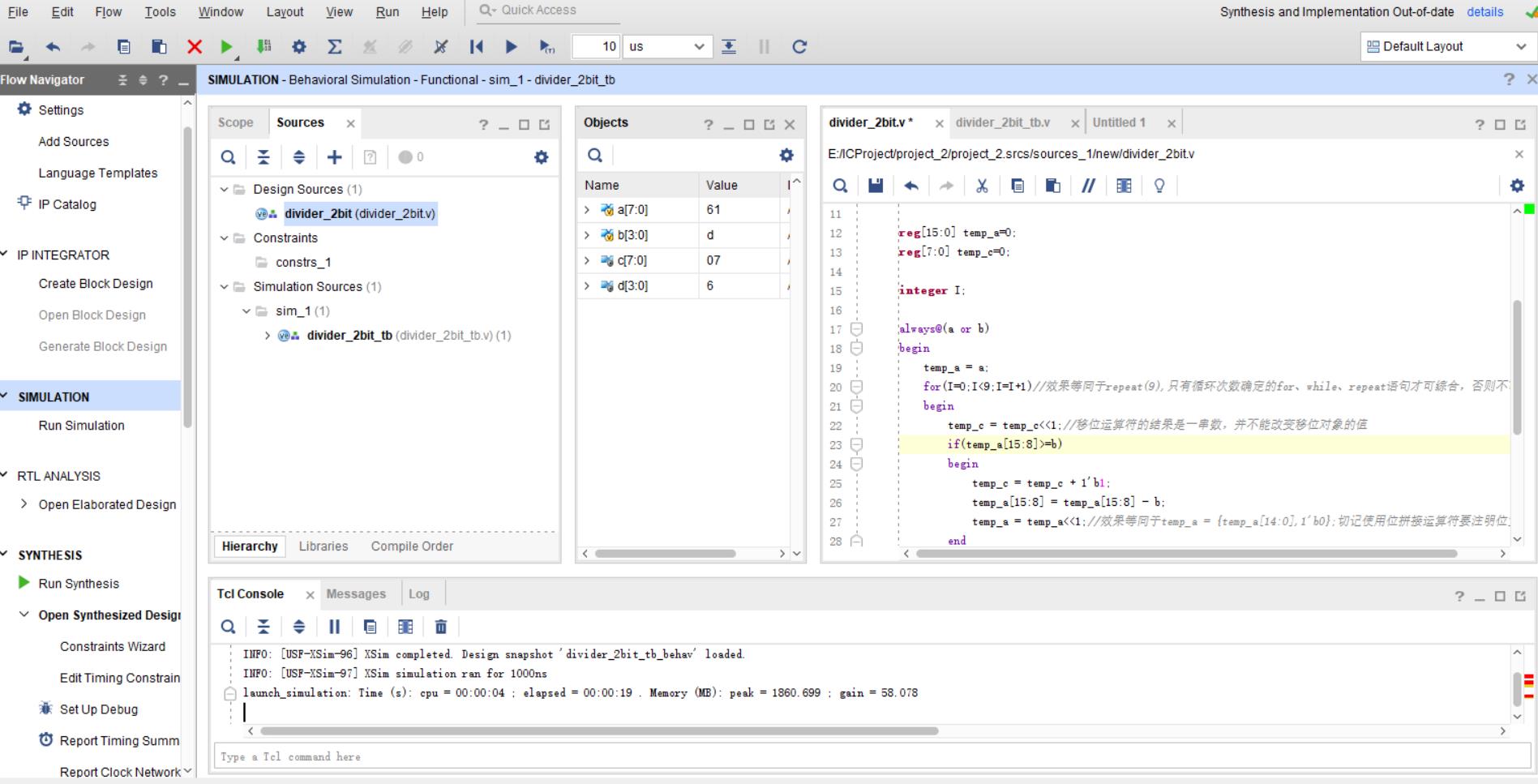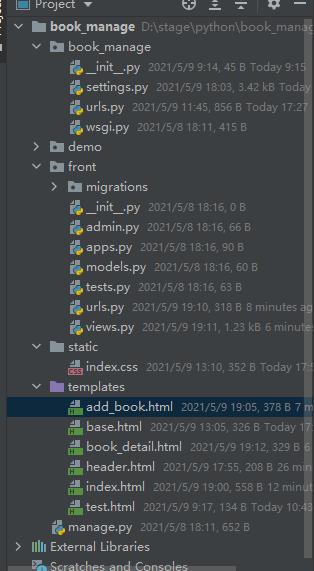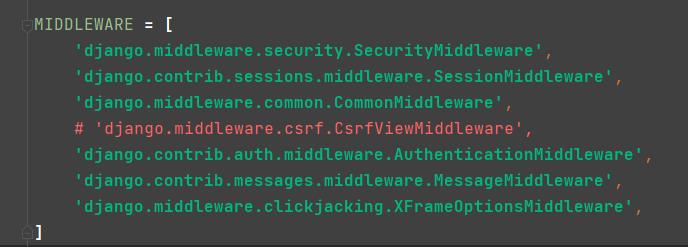Vivado使用之小练习
Posted 有翅膀的大象
tags:
篇首语:本文由小常识网(cha138.com)小编为大家整理,主要介绍了Vivado使用之小练习相关的知识,希望对你有一定的参考价值。


`timescale 1ns / 1ps ////////////////////////////////////////////////////////////////////////////////// /*二进制无符号整数除法*/ module divider_2bit(a,b,c,d); input [7:0]a;//a为被除数 input [3:0]b;//b为除数 output reg[7:0]c;//c为商 output reg[3:0]d;//d为余数 reg[15:0] temp_a=0; reg[7:0] temp_c=0; integer I; always@(a or b) begin temp_a = a; for(I=0;I<9;I=I+1)//效果等同于repeat(9),只有循环次数确定的for、while、repeat语句才可综合,否则不可综合 begin temp_c = temp_c<<1;//移位运算符的结果是一串数,并不能改变移位对象的值 if(temp_a[15:8]>=b) begin temp_c = temp_c + 1\'b1; temp_a[15:8] = temp_a[15:8] - b; temp_a = temp_a<<1;//效果等同于temp_a = temp_a[14:0],1\'b0;切记使用位拼接运算符要注明位宽 end else temp_a = temp_a<<1;//不可写作temp_a = temp_a[14:0],0;因为0没有注明位宽 end c <= temp_c; d <= temp_a[12:9]; end endmodule

仿真代码:


`timescale 1ns / 1ns module divider_2bit_tb; reg[7:0] a; reg[3:0] b; wire[7:0]c; wire[3:0]d; divider_2bit u1(.a(a),.b(b),.c(c),.d(d)); initial begin a = 8\'b0001_1011; b = 4\'b0101; #100 a = 8\'b1001_1011; b = 4\'b0001; #100 a = 8\'b0000_0011; b = 4\'b1101; #100 a = 8\'d250; b = 4\'d15; #100 a = 8\'d6; b = 4\'d3; #100 a = 8\'d97; b = 4\'d13; end endmodule
仿真如下:

备战Django之小案例(增删图书)
使用原生sql语句来实现一个增删操作
文件项目目录结构

先来看主路由配置
urlpatterns = [
path('book/', include(('front.urls', 'front'), namespace='front')),
]
__init__.py
import pymysql
pymysql.install_as_MySQLdb()
setting.py

Django配置连接数据库:
在操作数据库之前,首先先要连接数据库。这里我们以配置MySQL为例来讲解。Django连接数据库,不需要单独的创建一个连接对象。只需要在settings.py文件中做好数据库相关的配置就可以了。示例代码如下:
DATABASES = {
'default': {
# 数据库引擎(是mysql还是oracle等)
'ENGINE': 'django.db.backends.mysql',
# 数据库的名字
'NAME': 'dfz',
# 连接mysql数据库的用户名
'USER': 'root',
# 连接mysql数据库的密码
'PASSWORD': 'root',
# mysql数据库的主机地址
'HOST': '127.0.0.1',
# mysql数据库的端口号
'PORT': '3306',
}
}
front中的路由
urlpatterns = [
path('', views.index, name="index"),
path('add_book/', views.add_book, name="add_book"),
path('book_detail/<int:book_id>/', views.book_detail, name="book_detail"),
path('book_delete/', views.book_delete, name="book_delete"),
]
base.html
<!DOCTYPE html>
<html lang="en">
<head>
<meta charset="UTF-8">
<title>Title</title>
{% load static %}
<link rel="stylesheet" href="{% static 'index.css' %}">
</head>
<body>
<div class="center">
{% include 'header.html' %}
{% block centos %}
{% endblock %}
</div>
</body>
</html>
header.html
<nav class="nav">
<ul >
<li><a href="{% url 'front:index' %}">首页</a></li>
<li><a href="{% url 'front:add_book' %}">发布图书</a></li>
</ul>
</nav>
index.html
{% extends 'base.html' %}
{% block centos %}
<table>
<thead>
<tr>
<th>序号</th>
<th>书名</th>
<th>作者</th>
</tr>
</thead>
<tbody>
{% for book in books %}
<tr>
<td>{{ forloop.counter }}</td>
<td><a href="{% url 'front:book_detail' book_id=book.0 %}">{{ book.1 }}</a></td>
<td>{{ book.2 }}</td>
</tr>
{% endfor %}
</tbody>
</table>
{% endblock %}
add_book.html
{% extends 'index.html' %}
{% block centos %}
<form action="{% url 'front:add_book' %}" method="post">
<lable>
书名:<input type="text" name="name" placeholder="请输入书名">
作者:<input type="text" name="author" placeholder="作者">
</lable>
<input type="submit" value="提交">
</form>
{% endblock %}
book_detail.html
{% extends 'index.html' %}
{% block centos %}
<p>书名:{{ book.1 }}</p>
<p>作者:{{ book.2 }}</p>
<form action="{% url 'front:book_delete' %}" method="post">
<input type="hidden" name="book_id" value="{{ book.0 }}">
<input type="submit" value="删除按钮">
</form>
{% endblock %}
views.py
from django.shortcuts import render, redirect, reverse
from django.db import connection
# Create your views here.
def get_corsor():
return connection.cursor()
def index(request):
cursor = get_corsor()
cursor.execute("select * from book")
books = cursor.fetchall()
return render(request, 'index.html', context={"books": books})
def add_book(request):
if request.method == 'GET':
return render(request, 'add_book.html')
else:
name = request.POST.get("name")
author = request.POST.get("author")
cursor = get_corsor()
cursor.execute("insert into book(id,name,author) values(null,'%s','%s')" % (name, author))
return redirect(reverse('front:index'))
def book_detail(request, book_id):
cursor = get_corsor()
cursor.execute("select * from book where id=%s" % book_id)
book = cursor.fetchone()
return render(request, 'book_detail.html', context={"book": book})
def book_delete(request):
print(1)
cursor = get_corsor()
book_id = request.POST.get("book_id")
print(book_id)
cursor.execute("delete from book where id=%s" % book_id)
return redirect(reverse('front:index'))
成功代码


在Django中使用原生sql语句操作其实就是使用python db api的接口来操作。如果你的mysql驱动使用的是pymysql,那么你就是使用pymysql来操作的,只不过Django将数据库连接的这一部分封装好了,我们只要在settings.py中配置好了数据库连接信息后直接使用Django封装好的接口就可以操作了。示例代码如下:
使用django封装好的connection对象,会自动读取settings.py中数据库的配置信息
from django.db import connection
# 获取游标对象
cursor = connection.cursor()
# 拿到游标对象后执行sql语句
cursor.execute("select * from book")
# 获取所有的数据
rows = cursor.fetchall()
# 遍历查询到的数据
for row in rows:
print(row)
以上的execute以及fetchall方法都是Python DB API规范中定义好的。任何使用Python来操作MySQL的驱动程序都应该遵循这个规范。所以不管是使用pymysql或者是mysqlclient或者是mysqldb,他们的接口都是一样的。更多规范请参考:https://www.python.org/dev/peps/pep-0249/。
以上是关于Vivado使用之小练习的主要内容,如果未能解决你的问题,请参考以下文章